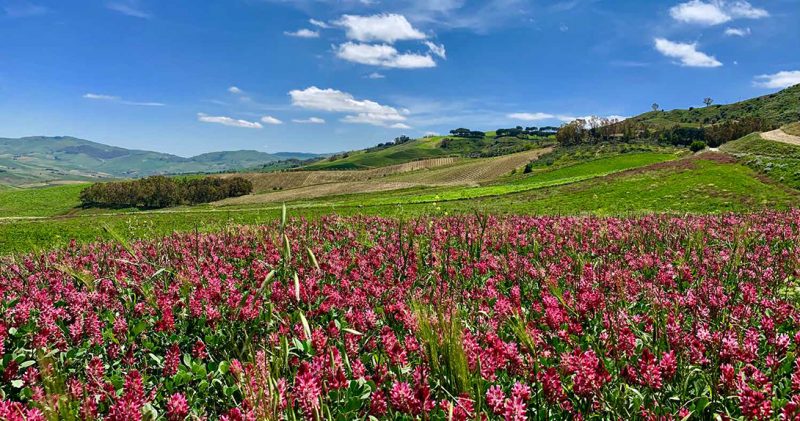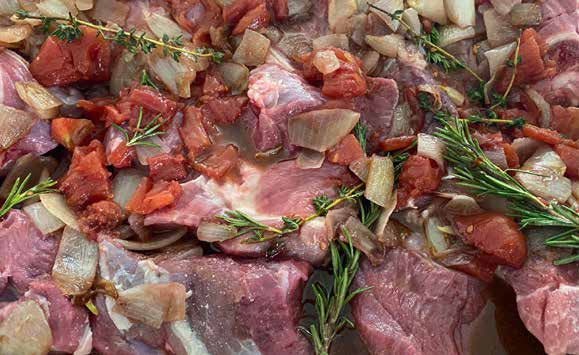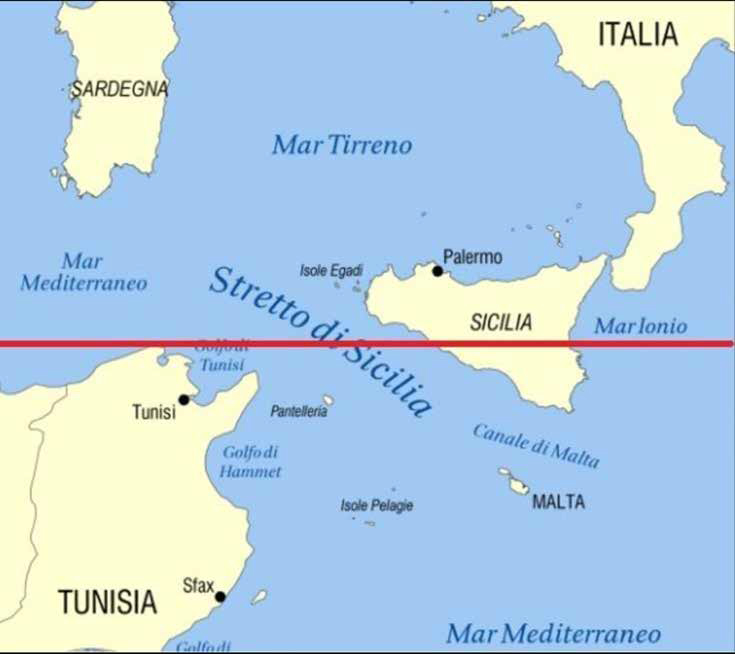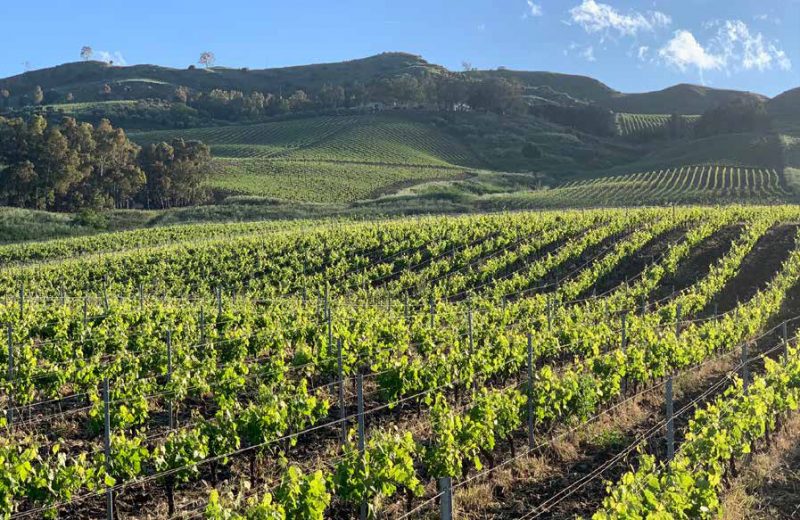This article originally appeared in the Winter 2021/2022 print issue of Quench Magazine.
Imagine a land where emerald-green grain fields are surrounded by snow-filled mountain peaks which cast their shadow on deep blue seas, a land where animals graze on wild herbs and produce milk that varies daily in flavor depending on their intake.
Imagine a land so fertile that fruit trees sprout from the ground, simply because a few pits were spit out by a farmer who stopped for a snack, a land where a tomato tastes like the exaggerated version of itself simply because the intense summer sun concentrated its flavors. Imagine a sea so abundant that a simple fishing net tossed with ease from a boat comes back overflowing with sardines.
Imagine a land where you can immerse yourself fully in nature, where there are areas still untouched by globalization. This earthly paradise is Sicily, the land where I have always felt rooted, and the place that is now my home.
As a child I spent every summer in my grandmother’s small mountain village in southwestern Sicily. Throughout my life, I have dedicated both my academic and professional realms to the study and representation of Sicilian culture. The intriguing history of the island always fascinated me due to its unique existence as a crossroads of several opposing civilizations, and I became specifically enthralled with how centuries of history were tangible in the island’s cuisine. Through food, I found a means to travel in time through the two-thousand-year-old history of Sicily.
Several years ago, I made the life changing decision to relocate from New York City to Sicily where I live with my husband and family at Feudo Montoni, a winery and farm in the mountainous heart of the island. Every new day gives me the opportunity to experience local traditions firsthand. Yet, the deeper I delve into the roots of the cuisine, the more challenging it becomes to define Sicilian food or to simply name a few “traditional” dishes.
Outside of Sicily, Sicilian cuisine was once associated with dishes such as spaghetti with meatballs, recipes that were portrayed as Sicilian in various films about Sicily. Today the perception of the island is evolving and dishes such as caponata, pasta with sardines, rice balls and cassata are known as “typical” Sicilian dishes, but again this is an over simplistic conception. The island’s regional cuisine is one of the most nuanced and rich in all of Italy and before defining what is traditional and authentic, there are several influences to first put into context.
From province to province, from town to town, and from family to family, often a dish will have the same name in different areas, but the ingredients and preparation styles differ. How can one determine which is the most authentic version? Of course, everyone claims that their version is the “real” recipe, but I’ve come to understand that such claims of authenticity can only be made for one’s own area and family. Take something as simple as tomato sauce, for example. So many variations exist and there is no one recipe, starting with which variant of tomato plant to seed for the sauce. As my dear elderly aunt Zia Franca puts it: “Ogni ricetta ha l’impronta della fami-glia,” or “Every recipe contains the imprint of the family.” This vast range in the execution of so-called “traditional dishes” throughout Sicily cannot be underscored enough.
Just as Sicily is home to a mosaic of architectural remains from the past, combining Greek temples and Roman mosaics with medieval Jewish bathhouses, Norman palaces, and ornate late-Baroque-era cathedrals, Sicilian cuisine is a patchwork of different cultures and time periods. Because of its strategic position between North Africa and Europe, and its highly fertile soil, it has long attracted visitors, from invaders to traders. Over time, Sicilians have embraced several food traditions brought to their shores, melding techniques, recipes, and ingredients from other ethnic groups with the pre-existing cuisine.
Separated from mainland Italy by the Strait of Messina, Sicily is often referred to as a “con-tinent” not only because it is the largest island in the Mediterranean, but because there are so many “Sicilies” within the region. What is traditional in one area, is unknown in another. Sometimes the differences stem from the his-torical influences in a sub region. Just as each city has different predominant architectural influences, the same goes for the food. On the western coast, for example, where the North African influence remains strongly ingrained, couscous with seafood is an iconic dish. Alternatively, in Modica, on the southeastern corner of Sicily, artisanal Aztec-style chocolate is crafted, as it was brought to this area from the New World by Spanish conquistadors.

Every Sicilian dish can be considered a web of history. A perfect example is the cassata, a cake that most likely originated during the Muslim rule of Sicily in the tenth century. In Arabic, the word qas’ah means a large deep bowl, the vessel in which the dessert is prepared.
However, over the centuries the dessert transformed as new ingredients and cooking techniques were introduced to the island. The filling of the cake is prepared with ricotta, which existed as far back as the Greek period, and was written about by Homer in The Odyssey. The ricotta is sweetened with sugar, which was introduced to the island during the Muslim rule. During the Norman era, almond paste, invented in the convent of the Martorana, was added to the cake. Later the Spanish introduced chocolate, which was added to the filing. Toward the end of the nineteenth century, a Palermitan pastry chef, invented the so-called cassata siciliana, adding decorative pieces of candied fruit and a final cover of icing in a very ornate manner. Made in the round form of a sun, which sets and is reborn the next day, the cake is a symbol of the death and resurrection of Christ, and thus is a staple on the Easter table.
When speaking about Sicilian cuisine one must break down the island into its sub-regions and understand the geographic and climatic distinctions. While Sicily and its archipelago is divided into 9 provinces, in terms of cuisine the provinces do not create culinary sub-regions. To better understand the food traditions in broad terms, we should break down the island into northern, southern, eastern and western corners, as well as the coastal and internal areas of each corner. In addition, one must consider the differences between the food of the plains, hills, mountains and volcanoes, as well as the surrounding cities and villages. However, to describe such differences, it would take sev-eral volumes. Therefore, I will focus primarily on the main differences between the coastal areas and the interior heartland of the island.
In the interior areas of the island, on the outskirts of rural villages, are immense land-scapes, filled with forests and farmland. Wild herbs and plants, including wild fennel, bor-age, catamint, oregano, chard and nettles are staple ingredients in the local cuisine. It is in the core of the island where I live with my family, and where life seems to be frozen in the past. It’s an area where large expanses of grain and legumes are cultivated; in fact, historically, this area was known as the so-called “granary” of the Roman Empire. As a result, in our area, it’s normal to wake up to a serenade of delicate bells as flocks of sheep are herded around the land. This is an area where livestock are pastured, specifically cows, sheep and goats, and where cheesemaking is widespread.
In the mountainous forests, however, it is more common to find pigs, including the black pigs of the Nebrodi mountains, as well as wild game. In these areas preserved meats, such as salame and prosciutto are traditional. Histori-cally, in all interior areas, there were no traces of seafood but rather dishes prepared with meat, preserved meats and cheeses. In addi-tion, in the forest, mushrooms are foraged and are very typical in the sub-regional cuisines.
Moving towards the coastal areas, Sicily is surrounded by three seas: the Mediterranean Sea on the south, the Tyrrhenian Sea on its north coast, and the Ionian Sea on its Eastern coast. Swordfish historically hail from the rough waters in the Strait of Messina, the body of water situated between mainland Italy and Sicily. Tuna, on the other hand, was traditionally caught and processed by the tonnara on the Western coast, and Southeastern tip of the island, practices that date back to the Muslim rule. Today, the types of fish that are typically sold at the various ports not only depends on the location of the fish, but on the size of the port and the types of fishing boats. For instance, at the port of Sciacca, white shrimp are commonly found, as the boats are all day-boats, and the shrimp are caught locally. In Mazara del Vallo, rather, on the southwestern corner of the island, the boats go to sea for long periods to catch the prized red shrimp, which are fished in the waters around Tunisia.
When comparing a dish that is made both in the interior areas and the coastal areas, such as pasta with sardines, we can see how the recipes are influenced by their geographic position. In the coastal areas, such as around Palermo, pasta con le sarde is prepared in the spring when sardines are abundant in the sea. The fish pulp is cooked with onions, raisins, pine nuts and tender green fennel, which grows in abundance in the wild during the same period. In the interior areas, pasta con le sarde is also prepared, but in these areas, fresh seafood was historically unavailable, and the dish was classically prepared with preserved salted sardines or anchovies that were brought into the areas by merchants. To balance the saltiness of the fish, tomato sauce was added to the other ingredients. In Palermo, one would say that pasta con le sarde with tomato is a sacrilege, but ultimately both recipes are equally as authentic.
There are also multiple climatic zones, created by latitude and altitude. Such climate differences create areas where different types of food can be cultivated. For instance, in the southeastern tip of the island, which is located on the same latitude as Tunis, tomatoes and almonds are commonly cultivated.


Vineyards at Feudo Montoni
In water rich areas such as in the mountainous territory with natural springs and in the river basins, fruit is cultivated, with specific attention to citrus groves. In the forest areas, nuts such as chestnuts and walnuts are common. There is a specific climatic area with ideal conditions for most cultivation: prickly pears, cherries, pistachios, olive trees, etc. Of course, products from all around Sicily are available in the many bustling markets around the is-land, but when such delicacies are cultivated by a village, they tend to become integrated into the local family dishes.
Speaking of Sicilian food, I cannot omit the subject of wine. Here at our winery, we face the same questions regularly. Many ask us to describe the indigenous Sicilian grapes and their wine styles, such as Nero d’Avola, the princess of Sicilian grapes, and we are unable to provide a simple answer. The grape expresses itself in multiple ways depending on its geographical position and there is no such thing as “the” Nero d’Avola.
Traditional dishes are also based on the time of year, not only on the seasonality of a vegetable or fruit, but on a specific holiday. For instance, nowadays, arancine, or rice balls can be found all year round in Palermo and Catania, but they are traditionally eaten for the Feast of Saint Lucia, every December 13. For Saint Joseph’s Day, which falls every year on March 19, traditional doughnuts, known as sfinci are prepared, with countless variations around the island. A mere list of traditional holiday foods could fill all the pages in this publication, if not more.
Beyond its multi-ethnic makeup, Sicilian cuisine is characterized by a melange of both simple and complex preparations. Traditional Sicilian cooking stems from two main class distinctions: from aristocratic kitchens, where splendor and spectacle were of utmost impor-tance, and from the homes of the peasants, who were bound more by necessity but mus-tered a creative imagination that embodies Sicilian identity.
The aristocratic strain can be traced back to 1805, when Maria Carolina, the wife of Ferdinand I, the king of Sicily and Naples, and the sister of Marie Antoinette, imported French chefs to the royal court in Palermo. These chefs became known as monzù, a corruption of the word monsieur and a title used to emphasize the chefs’ superior status among the servants of the house. The elevated cuisine that resulted due to the presence of the monzù chefs was refined but bold, combining French technique with Sicilian ingredients. Gradually the cooks who had apprenticed under the French monzù took over the aristocratic kitchens and continued to bear the prestigious title.
Peasant cuisine, on the other hand, was meager and unrefined, but it too contained typical Sicilian ingredients. Like in most regions of Italy, there is a profound difference in the elaborate and embellished quality of aristocratic dishes with those of the masses, which were more simple and ingredient- driven. In Sicilian cuisine, however, several peasant dishes mirror foods of the upper class. In such preparations, expensive main ingredients are substituted with those of lesser value, and the name of the meager dish reflects its aristocratic origins. There is an underlying paradox when naming and modeling a peasant dish after an expensive aristocratic preparation, reflecting a sense of irony and cunningness that Sicilians value highly.
Convents are mainly to thank for the elaborate dessert tradition of the island. Before the advent of pastry shops in the nineteenth century, most sweets were produced by cloistered nuns who coveted the recipes, keeping them top secret. Initially, desserts prepared in convents were not sold to the public, but rather were gifted to bishops, dukes, counts, and others who helped support the mission of the sisters. Sweets such as frutta di Martorana (fruit-shaped marzipan), ova murina (spiced almond crêpes stuffed with milk custard), and cannoli were all born in the realm of the monastery. Nuns were usually the unmarried second daughters of noble families and often were accompanied by servants. Sometimes servants taught the nuns dessert recipes, while other times individual nuns devised their own personal creations.
Widespread throughout the island is cibo da strada, or street food. Although present in most Sicilian cities, street food is ubiquitous in Palermo, and is available night and day. Dispersed in many corners of the capital, vendors sell a wide range of delicacies that are meant to be eaten while standing.
To understand Sicilian cuisine is a challenging undertaking, not so much for the realization of the recipes, but for the historical and cultural context behind the recipes. Sicilian cuisine is like its people: mysterious, pro-found, very kind, appetizing and a mixture of different cultures. But as soon as you enter the realm of Sicilians, you are transported immediately to a second level, in which you can perceive a certain melancholy and joyful vision of life akin to the agrodolce (the sweet and sour element), made up of vinegar and sugar that goes into an eggplant caponata. Thereafter is another, much deeper level, revealing the Sicilians’ sensitivity and secretive nature.
And there is yet another level in which you succumb to a “disease” known as sicilitudine, from which you cannot heal yourself and there is no cure and you end up like me: not being able to live without Sicily

Check out the recipe for Capretto al Forno di Nonna Adele (Grandma Adele’s Roasted Goat), a recipe “authentic” to Melissa’s family Christmas Sicilian table that she shares with pleasure with Quench’s readers.
Melissa Muller is an anthropologist and writer based in Sicily. Born and raised in New York, she holds a master’s degree in journalism from Columbia University. Her studies revolved around the gastronomy of the Mediterranean regions with specific focus on Sicily, the island from where her maternal grandmother hailed. After her studies, Melissa opened a Sicilian restaurant in New York City that become a laboratory where she shared her love of Sicilian cuisine, along with her cultural research of the island. After several years of intense research, she wrote Sicily: Recipes Rooted in Tradition (Rizzoli). A time came when her distance from Sicily no longer satisfied her soul, and although she had created a corner of Sicily in Manhattan, Melissa made a life changing move to her beloved Sicily. She now lives with her family at Feudo Montoni, her husband Fabio’s organic farm and winery in the center of the island, where she is specifically dedicated to the organic cultivation of heritage Sicilian plants and the production of food products. She is assembling her fieldwork for a second book, a work of narrative non-fiction with recipes intertwined that will focus on the uncontaminated rural heart of Sicily that is now her home.


